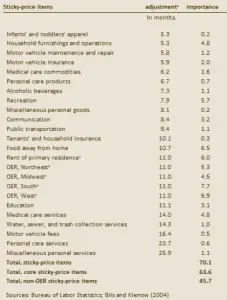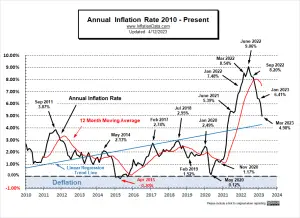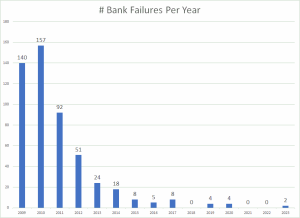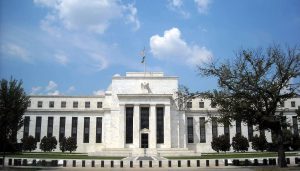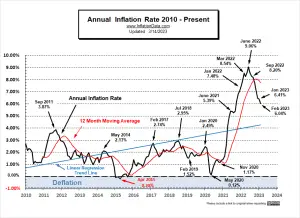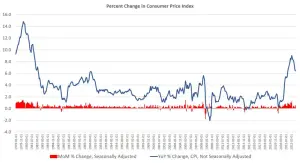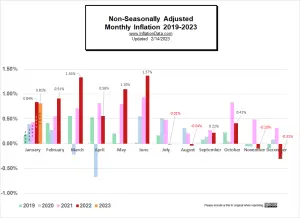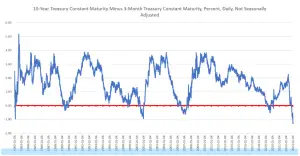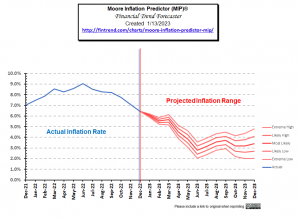What Is Price Stickiness? Price stickiness, aka. "Sticky prices" are prices that tend not to change very quickly. So, despite costs (or demand) going up, a business with "sticky prices" may not raise its prices for an extended period of time. In other words, sticky prices tend to change slowly despite changing underlying factors. Sticky prices are a key component of Macroeconomic theory. Why wouldn't a business raise prices if its costs are going up? You would think that most products and services would respond to the laws of supply and demand, i.e., when demand goes up, prices quickly follow. Or, when underlying costs rise a business would automatically raise its own prices to maintain … [Read more...]
Inflation Less Than Experts Predict in March
Annual inflation PLUNGED in March according to the Bureau of Labor Statistics CPI report released on April 12th. Monthly inflation was 0.33% for March 2023, compared to 1.34% in March 2022. This resulted in a 1% drop in Annual inflation. But despite the significant drop in inflation, the stock market did not rally. Instead, the NYSE lost a few points, and the NASDAQ lost just over 100 points. March 2023 Inflation Summary: Annual Inflation fell from 6.04% to 4.98% CPI Index rose from 300.840 to 301.836 Monthly Inflation for March was 0.33% Next release May … [Read more...]
The 3 Major Causes of Bank Problems
There are three major categories of problems that can cause bank instability. In his article "A Tale of Two Crises" Bloomberg's John Authers tells us that they are: a liquidity crisis- When customers pull their money out. a solvency crisis- When borrowers can fail to repay their loans. a confidence crisis- When shareholders sell the bank's stock, sending their shares down making it harder to raise money. And beyond true crises, changes in economic and financial conditions can attack their profits — which is bad for shareholders and ultimately might tend to imperil everyone connected to the bank. Understanding a Liquidity Crisis One of the primary causes of a Liquidity … [Read more...]
Central Banks Respond Differently to the Banking Crisis
Central bankers don't like surprises, so they tend to communicate among themselves in order to coordinate their response to every new crisis. And this week there was a wave of responses to the combination banking crisis and still high inflation. The Cause Raising interest rates from near zero to over 4.5% in a short period of time puts stress on banks' liquidity as it causes an "inverted yield curve", i.e., short-term interest rates are higher than the locked-in long-term rates. Thus banks are paying out more (on short-term deposits) than they are receiving (on long-term mortgages). The Effect So you would think the Central Bankers would be prepared to deal with the … [Read more...]
Stock Market Ignores Lower Inflation in February
The Bureau of Labor Statistics reported that Annual Inflation fell from 6.41% in January to 6.04% in February Monthly inflation was 0.56% for February 2023, compared to 0.91% in 2022. Despite the significant drop in inflation the market was more concerned with bank failures so, there was no inflation rally. February Inflation Summary: Annual Inflation fell from 6.41% to 6.04% CPI Index rose from 299.170 to 300.840 Monthly Inflation for February was 0.56% Next release April … [Read more...]
How Loose Monetary Policies Cause Recessions
Advocates of Keynesian economics believe the Federal Reserve should pursue policies that will prevent the possible decline of the economy into a liquidity trap. But what is a liquidity trap? Economic activity often is presented in terms of a circular flow of money. Spending by one individual becomes part of the earnings of another individual, and spending by another individual becomes part of the first individual’s earnings. Recessions, by this thinking, occur because consumers—for whatever reason—have decided to cut spending and increase their savings. For instance, if people become less confident about the future, they are likely going to lower their outlays and hoard money. … [Read more...]
Food and Shelter Prices Keep Climbing as CPI Growth Hits a Three-Month High
The federal government’s Bureau of Labor Statistics (BLS) released new price inflation data today, [i.e., February 14th], and according to the report, price inflation during the month decelerated slightly, coming in at the lowest year-over-year increase in sixteen months. According to the BLS, Consumer Price Index (CPI) inflation rose 6.4 percent year over year in January before seasonal adjustment. That’s down very slightly from December’s year-over-year increase of 6.5 percent, and January is the twenty-third month in a row with inflation above the Fed’s arbitrary 2 percent inflation target. Price inflation has now been above 6.0 percent for sixteen months in a row. [Editor's note: … [Read more...]
January 2023 Inflation “Disappointing”
The Bureau of Labor Statistics reported that Annual Inflation fell from 6.45% in December 2022 to 6.41% in January 2023. Monthly inflation was much higher than expected for January, resulting in a much smaller loss than most experts predicted. With 0.84% monthly inflation for January set to fall out of the calculations, the opportunity for a significant drop in inflation was possible. Monthly inflation for both November and December was negative so it seemed possible that January inflation could be moderate, but instead, it came in at a whopping 0.80%, just 0.04% lower than January 2022, resulting in a minuscule 0.04% decline in the annual inflation rate. January Inflation … [Read more...]
Is The Fed Flashing Signs It’s Done Raising Rates?
The Federal Reserve’s Federal Open Market Committee (FOMC) on Wednesday raised the target policy interest rate (the federal funds rate) to 4.75 percent, an increase of 25 basis points. With this latest increase, the target has increased by 4.5 percent since February 2022, although this latest increase of 25 basis points is the smallest increase since March of last year. Indeed, the FOMC has slowed its rate of increase over the past three months. After four 75 basis point increases in 2022, the committee approved a 50-point increase in December, followed by the 25-point increase this week. In other words, the FOMC has been slowed down in its monetary tightening. The committee was … [Read more...]
Falling Inflation is Good for Stocks
Historically, Stocks tend to soar in years when inflation is falling. But typically, inflation doesn't fall until the fed-funds rate rises above the current inflation rate... The last data we have as of this writing is that inflation was 6.45% in December, and the FED funds rate was 4.1%. That is still a significant gap. But inflation is already falling. Monthly inflation began a dramatic slowdown last July. Monthly inflation has fallen by 80% over that timeframe (bringing annual inflation down by 33%). At this point, the majority of our annual inflation occurred during the first six months of 2022. January through June of 2022 had an average of 1.02% inflation per month. The second … [Read more...]

